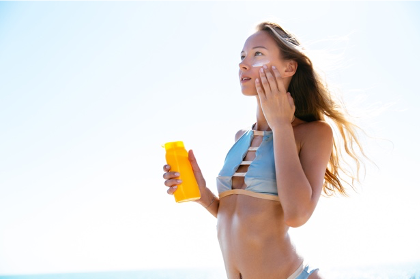
Sunrays are necessary and of great benefit both for the body and mood. They favor vitamin D synthesis, bone calcification, and improve some skin conditions.
However, excessive sunbathing can carry a high risk of burns, skin aging and even skin cancer. It is important to keep in mind that the perfect tan is only a mechanism of the skin to protect against ultraviolet radiation. Therefore, to enjoy the benefits of the sun, it is important to protect the skin.
Sunlight is an electromagnetic radiation with a continuous and very wide spectrum of wavelengths. However there are two types of radiation transmitted by sunlight that can cause skin damage.(1)
UV-A rays make up 95% of the ultraviolet radiation that reaches the surface of the skin. It is painless but capable of penetrating the skin to the cells of the dermis. This can induce the production of free radicals, and in the long term cause photoaging, pigmentation problems and skin cancer. UV-B radiation is responsible for tanning, but also for sunburn, allergic reactions and other types of skin cancer. (2)
As a result, skin care and protection is becoming a trend nowadays, especially if you have planned a trip to the beach. Sun protection consists of the use of sunscreens, products that prevent exposure to UVA or UVB radiation. According to their mechanism of action they can be:
By absorption: they consist of molecules capable of absorbing radiation energy and subsequently transforming it into another type of energy. The most commonly used are benzophenones. (1)
By reflection / dispersion: particles that reflect solar radiation. For example titanium dioxide and / or zinc oxide. (1)

Together with organic or inorganic sunscreen filters, they also contain inactive ingredients such as antimicrobial preservatives, humectants and antioxidants.
But, how sunscreens impact the environment?
Recently, scientists have discovered that some chemical ingredients used for sunscreen formulations have an impact on marine corals and other aquatic species. Sunscreen ingredients like benzophenone, ethylhexyl methoxycinnamate, homosalate and minerals like titanium dioxide and zinc oxide have been identified in coastal waters. (3)
The UV filters can reach the coastal waters directly as a result of washing off swimmers or indirectly from wastewater treatment plants. (5,7) Several of these compounds have been found in marine biota, such as mollusks, certain species of fish, corals and even in sediments.(3) Recent studies have shown that components of skincare products have negative effects on marine organisms, mainly because they might undergo photodegradation, being converted into toxic products. (4)
Sunscreens are suspected to produce harm to coral reefs. However, the coral bleaching is not yet clear to the scientific community.(8) There are other variables to consider such as climate change, overfishing and nutrient pollution, that have a great impact on the marine ecosystem.(6)
This is one of the main reasons that have prompted the need of “green” products ecologically friendly. Consequently, industry is studying new compounds derived from plants, which have shown the ability to block or absorb UV radiation. These active principles are mainly flavonoids, carotenoids, tannins and anthraquinones(1) The addition of natural compounds to the chemical/synthetic ones could be a successful strategy to prevent ecosystems deterioration.
In conclusion, manufacture and consumption of sun products is increasing exponentially, with potentially harmful consequences to the marine ecosystem. Nevertheless, further research and evidences are needed to understand better the safety of the ingredients in sunscreens and their impact to the aquatic species.
References:
1. Pandika, Melissa. “Looking to Nature for New Sunscreens.” ACS central science vol. 4,7 (2018): 788-790. doi:10.1021/acscentsci.8b00433
2. Segovia, M. 2016. Pigmentación solar. Universidad del Valle de Guatemala.
3. https://www.icriforum.org/sites/default/files/ICRI_Sunscreen_0.pdf (accessed on November 03, 2019).
4. Danovaro, Roberto et al. “Sunscreens cause coral bleaching by promoting viral infections.” Environmental health perspectives vol. 116,4 (2008): 441-7. doi:10.1289/ehp.10966
5. Sánchez, D. Tovar, A. “Are sunscreens a new environmental risk associated with coastal tourism?” Environment International 83 (2015) 158–170 . http://dx.doi.org/10.1016/j.envint.2015.06.007
6. https://www.theguardian.com/fashion/2019/jun/19/could-banning-sunscreens-to-save-coral-do-more-harm-than-good (accessed on November 10, 2019).
7. https://www.nationalgeographic.com/travel/features/sunscreen-destroying-coral-reefs-alternatives-travel-spd/ (accessed on November 10, 2019).
8. https://earther.gizmodo.com/the-jurys-still-out-on-how-bad-sunscreens-are-for-coral-1837738863 (accessed on November 10, 2019).
Credit for images
Sunscreen <a href="https://www.freepik.es/fotos-vectores-gratis/agua">Foto de Agua creado por freepic.diller - www.freepik.es</a>

Comentários